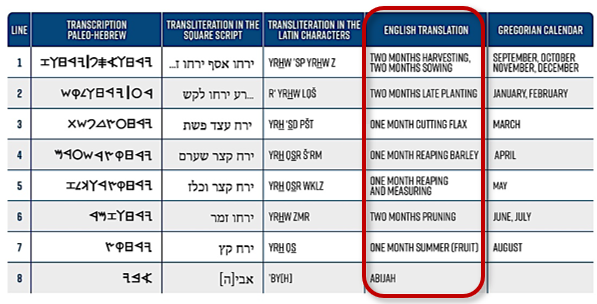 While today’s youth stare at a palm-sized device known as a cell phone looking for amusement, young Jewish boys during King Solomon’s reign would have looked at a soft limestone tablet of the same size, practicing their writing skills. A stunning 10th century BC exemplar was found in 1908 by R.A.S. Macalister, 20 miles west of Jerusalem in the ancient town of Gezer. The Gezer Calendar [1] (right) lists out their annual agrarian schedule, giving insight into their daily lives.
While today’s youth stare at a palm-sized device known as a cell phone looking for amusement, young Jewish boys during King Solomon’s reign would have looked at a soft limestone tablet of the same size, practicing their writing skills. A stunning 10th century BC exemplar was found in 1908 by R.A.S. Macalister, 20 miles west of Jerusalem in the ancient town of Gezer. The Gezer Calendar [1] (right) lists out their annual agrarian schedule, giving insight into their daily lives.
Though originally a rewritable surface, abandonment and hardening over the years now permanently capture seven lines of a schoolboy’s writing assignment. (Girls of antiquity were typically not taught the skill of writing.) The table [2] below deciphers the first 6 lines into Hebrew script, its Latin equivalent, and an English translation, along with our calendar month. The 7th line reveals the author and his common name: Abijah.

From this short memory aid, we see the Hebrews’ farm calendar began in the time of harvest, coinciding with the Feast of Tabernacles. All Israelites enjoyed this large fall festival which occurred in the 7th month (Tishri), marking the end of the civil year (Ex. 23:16) and the beginning of the next agricultural year (Lev. 23:23-44). Land sabbaths and jubilees, also in Tishri, are likely not mentioned as they were irregular and special events. Rosh Hashanah today corresponds to Tishri 1. [3]
The discovery of an educational device like the Gezer Calendar gives additional insight into training of Hebrew boys. So important was the instruction of their youth that Josephus writes, “Our ground is good, and we work it to the utmost, but our chief ambition is for the education of our children…We take most pains of all with the instruction of children, and esteem the observation of the laws, and the piety corresponding with them, the most important affair of our whole life.” [4] To denote the Hebrew youth as the most important member of the Jewish society is not an overstatement. A life of instruction was highly valued and remains so today. The Jews began educating their children at the age of 5-7 years old. According to an ancient Rabbinical book, Sayings of The Fathers, the academic curricula was as follows: “At five years old, Scripture; at ten years, Mishnah; at thirteen, the Commandments; at fifteen, Talmud.” No Egyptian learning in here.
This meant scripture memorization began at the earliest possible age, even as Moses commanded. Family attendance at the religious festivals gave the father an additional opportunity to explain Jehovah’s providence in history and promises for the future.
Though not an easy task, faithful Jews understood its value. A Rabbi captured a communal admonition: “Give thyself trouble to learn the Law, for it is not obtained by inheritance.” Apparently this tradition carried on into New Testament, for Paul said of Timothy that from a child thou hast known the holy scriptures, undoubtedly taught him by his mother Eunice. This admonishment remains relevant today: Set your hearts unto all the words which I testify among you this day, which ye shall command your children to observe to do, all the words of this law. For it is not a vain thing for you; because it is your life. What does this say to our generation, our culture, our nation, and our families?
[3] Source: Rose Book of Bible Maps, Charts and Timelines, 2005, pg.60.
[4] Source for all blue quotes: https://worldhistory.us/ancient-history/ancient-jewish-education-of-children-and-use-of-scripture.php
Like this? Consider sharing it to Facebook by clicking the linked icon below.
